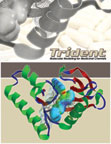|
The Trident Graphical User Interface.
A single, fully-integrated, and easy to use interface provides medicinal chemists with tools for building (Organic and Substituent model kits) and importing structures (common molecular file types), database query (access to provided Spartan Molecular Database collection, the Cambridge Structural Database <requires license>, and the Protein Databank), task submission (a single calculations dialogue accesses all computational and graphics requests), and visualization of results (Trident graphics, property and similarity dialogues, spreadsheets, plots, and text output).
Model Kits:
|
Organic
|
Accesses a builder consisting of organic elements and common bond types (e.g., "sp3 carbon"), functional groups, rings, and custom menus accessing provided libraries of common substructures and the ability to add your own libraries.
|
|
Substituent
|
Provides tools for easily constructing libraries of substituted systems by adding common functional groups or your own custom groups at selected positions on a common molecular scaffold.
|
|
Building
|
Accesses a builder of amino acids for construction of polypeptides as a helices, b sheets or in user-defined conformations.
|
Graphical Displays:
|
Molecule Display
|
Trident includes several display styles for visualizing molecules: wire, ball-and-wire, tube, ball-and-spoke, and space filling models.
|
|
Hydrogen Bonds
|
Optional display of hydrogen inter- and intra- molecular hydrogen bonds are available.
|
|
Biopolymers
|
Secondary structures for Polypeptides and polynucleotides can be optionally rendered with "ribbon" displays, lines, or beads. Colors may be configured to emphasize strand, secondary structure, or residue type.
|
|
Chemical Function Descriptors
|
Trident can graphically display chemical function descriptors (CFD's), identifying hydrogen bond acceptors and donors, positive and negative ionizable centers, aromatic rings, and hydrophobes. Users can vary CFD definitions.
|
Computational Methods.
Trident provides a targeted set of computational methods, addressing the needs of medicinal chemists. All methods are easily accessed via Trident's seamless graphical interface.
|
Molecular Mechanics
|
Molecular mechanics is presently the only practical method for calculations on very large molecules or for conformational searching on molecules with a large number of degrees of freedom. MMFF94, in particular, has proven to be a reliable and fast tool for conformational analysis. There are no atom limits for molecular mechanics calculations.
Trident molecular mechanics calculations also include optional aqueous solvent energy corrections.
|
|
Semi-Empirical Molecular Orbital
|
Semi-empirical models are the simplest of the quantum chemical schemes, and are useful for equilibrium and transition-state structure calculations. PM3, in particular, has proven to be a reliable tool for geometry calculations on transition metal inorganic and organometallic compounds.
Trident includes PM3 methods with parameter extensions for heavy main-group elements for most transition metals.
|
|
Hartree-Fock Molecular Orbital
|
Hartree-Fock models are well documented standards for predicting structure, energy and property calculations, in particular for organic molecules.
Trident provides two versatile basis sets: 3-21G and 6-31G*.
|
Tasks Performed by Trident for Windows:
|
Structure/Property
|
Trident utilizes quantum mechanics to determine total energy (Hartree-Fock) or heat of formation (PM3) for either initial geometry or optimized geometry. A number of useful values follow from determining the wavefunction including energy, aqueous energy, energy of HOMO and LUMO, atomic charges and dipole moments. Additional properties are determined by Trident's property module including molecular weight, area, volume, polar surface area, LogP, electronegativity, hardness, and ovality.
|
|
Molecular Shape
|
Provides access to Trident's molecular mechanics engines for conformational searching, determining the "Best Conformer", "Good Conformers", using either systematic or Monte-Carlo approaches in either gas-phase of aqueous environments. Additionally Trident generates "Conformer Libraries" invoking a procedure for determining the minimum set of conformers required to span conformational space, of significant utility in similarity analysis. Trident also provides geometry optimization with molecular mechanics providing strain energy.
|
|
Similarity Analysis
|
Trident quantifies molecular similarity based on atoms, chemical functional descriptors, or pharmacophores.
|
|
|
|
